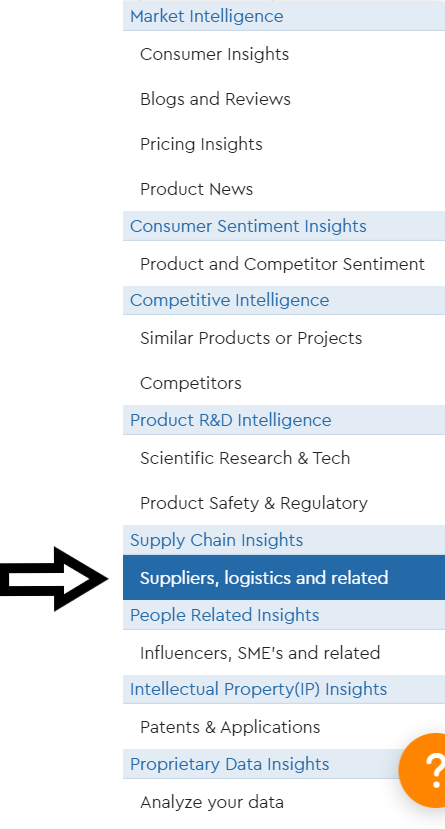
13 Jan
Supply Chain: What it is and how AI technology impacts it
Supply chain management is one of the essential tasks a company should do well to gain competitiveness and achieve market dominance by overcoming obstacles and challenges. But what would it be like if a company could view and analyze the supply chain strategies of its competitors? Now, with AI technology and devToM, this is possible and can be a strategic advantage for the business, providing it with top benefits.
Before we delve further into the advantages of devToM and AI technology, we will define a supply chain.
What is a supply chain?
A supply chain is a network of diverse professionals collaborating to produce a particular product. This network includes many individuals, ideas, activities, partnerships, and services. It also encompasses the entire process and all professionals involved, from product conception to customer purchase.
An optimized supply chain generates minimal expenses and a more effective product cycle. Therefore, businesses should enhance their supply chains to save money and keep up with the competition.
To illustrate the size and significance of a supply chain to an organization, consider a mobile phone. The initial phase of the supply chain entails the procurement of raw materials and their transport to production, ending with the delivery of the finished phone to a retail distribution center. In a few words, the ultimate objective is the customer's purchase of the product, and all the processes are designed with this objective in mind.
Thus, all supply chain participants may be producers, suppliers, warehouses, transportation companies, distribution centers, sellers, employees, or retailers.
When a company accepts a demand from a client about a product and decides to release it onto the market, the supply chain begins to function. At the center of the preceding are the customers, their pain points, and the needs the product intends to fulfill. Consequently, its core operations contain product development, marketing, operations, networks, finance, and customer service.
Effective supply chain management can reduce an organization's overall costs and increase its profitability. However, if something in the chain breaks, it can impact the others in the supply chain in many ways, be costly, or even necessitate starting all over.
How can the supply chain be made more efficient?
Supply chain management may be a complicated process for a business, but AI technology can make it easier. In particular, AI technology can simplify operations within the supply chain and help the company comprehend what is occurring in their or competitors' networks. This is a valuable and significant competitive advantage and makes devToM the ideal ally for businesses offering substantial benefits in AI technology.
Sign-up to devToM and get your FREE 30-Days trial now!

- The company can prepare for various challenges with devToM, specifically Supply Chain Intelligence. Amongst others, some are distribution networks, manufacturing partners, logistics, shipping, and consumer product availability. Consequently, the company better understands the processes, people, and steps required for a successful Supply Chain.

- devToM provides the ability to find valuable information about competitors in every industry, transforming raw data into actionable intelligence and enabling businesses to:
- Discover everything about the supply chains of competitors.
- Identify optimal supply chain paths for products.
- Receive updates on industry conferences and events where potential partners may be present.
- Reduce distribution costs and the likelihood of errors that can have harmful economic and administrative repercussions.

What are the primary benefits of devToM?
The primary benefit of devToM is its usability and universality across all businesses. Thus, regardless of whether a company is a startup or at a senior level, it can enjoy the same benefits from AI without discrimination or restrictions. Therefore, AI is no longer reserved for a select few businesses but is becoming an essential tool for all organizations that wish to explore and reap its benefits. devToM provides AI technology and development services, requiring companies only desiring to evolve and surpass the competition.

Regarding the supply chain, its most significant benefits are:

- Access a massive database of wholesalers
- Make choices based on market data.
- Develop a robust distribution network
- Observe rivals' strategies
- Receive updates about events and conferences
- Identify new possibilities
- Reduced distribution expenses
- Boost the company's sales
Why is it beneficial to study competition?
Studying the competition delivers centralized management for multiple phases like innovation, organizing, planning, creation, manufacturing, inventory, and distribution. Those phases are necessary to produce and sell a company's products.
In addition, competitive analysis for supply chain management has additional benefits. One of them is increasing efficiency by harmonizing the actions of the different commodities within the supply chain. This can lead to a company gaining a competitive advantage over its competitors. It also improves the quality of its products, which can result in increased sales and revenue.
How can an organization manage its supply chain?
Depending on the industry to which it belongs, the level of competition, and the objectives it has set, each company can take different steps to conquer the supply chain. However, if the company is to succeed, it must follow six concrete and practical steps in a specific order:
- Designing the inventory and manufacturing procedures to guarantee that supply and demand are adequately balanced so that customers are satisfied and there is no pressure or friction during product production.
- Manufacturing or sourcing the materials required to create the final product, verifying the quality of the products, the quantities required, and the availability of materials.
- Assembling components and testing the product to achieve the best outcome and prevent production errors.
- Preparing the product for shipment or storing it in inventory until later before sending it out for sale.
- Transporting and providing the finished product to the wholesaler, retailer, or consumer.
- Assisting with customer service for returned items and resuming production based on renewed demand and supply.
Supply Chain Models
Before a company can be guided through the necessary steps for creating a supply chain, it must determine which productivity or supply chain model it adheres to.
- Continuous Flow Model. It functions well for businesses that produce identical products with slight variations. The products must be in high demand and need minimal redesign. This lack of fluctuation enables the involved parties to streamline production times and maintain tight inventory control. Companies need to replenish raw materials regularly to avoid production bottlenecks in this model. Automobile manufacturers may fall under this classification.
- Fast Chain Model. It works best for businesses that sell products based on recent trends. Companies utilizing this model must get their products to market rapidly to capitalize on the prevailing trend; if they delay, their product may become irrelevant, and the public will lose interest. They should move quickly from concept to prototype, production, and consumer. In this model, the greater the company's advantage over the competition, the faster it can create trends or follow them once they emerge. AI is the ideal technology for a business to identify trends and gain a competitive advantage. Companies in the fast fashion industry may fall into this category.
- Flexible Model. This is the ideal model for companies that produce seasonal or holiday merchandise. These businesses experience spikes in demand for their products, followed by extended lulls in demand. The adaptable model ensures they can rapidly ramp up production and shut down efficiently when demand declines. They should accurately predict their raw material, inventory, and labor requirements to be profitable. Consequently, these companies should be on high alert during their peak periods, and while they must cease production, they must do so without causing harm to the company or its chain partners. These businesses sell festive products for Christmas or other holidays.
The more advantages a model can offer a business, the more successful it is. For example, in addition to the previously mentioned capabilities, a supply chain model can:
- Consistently contribute to the company's growth and development, achieving goals against competitors swiftly and safely.
- Encourage collaboration between various sectors, departments, and professions to ensure a product's success and smooth flow.
- Seek out new technologies that enhance processes and alleviate problems.
- Include metrics that enable employees to evaluate the success or failure of each step.
- Be the driving force behind a product, transforming raw materials into a finished product sold to the general public.
By providing various benefits, AI helps in everything mentioned above, especially when analyzing the competition and keeping the business ahead of the others. In addition, AI facilitates a comprehensive, accurate, and thorough market examination. As well as its developments, changes, and competitors' activities.
At the beginning of Covid-19, businesses and the supply chain were utterly disorganized. However, companies with access to AI technology could rapidly modify their supply chain using their AI system, allowing them to surpass the competition.
Certainty dictates that companies will not be required to manage daily situations comparable to the pandemic. However, why shouldn't they always be prepared to overcome even the slightest obstacle? Due to the complex nature of the supply chain, even the most minor difficulty may cause a problem (because of the people and processes involved). Why should the business not anticipate these challenges by analyzing and overcoming the competition?
devToM's cutting-edge AI technology makes something like this highly probable. devToM is an AI-powered Product Development platform that converts and maintains product ideas; A SaaS application that enables product intelligence by combining the power of artificial intelligence, unstructured data, and a system of best practices.
With devToM, professionals can quickly identify risks and opportunities, analyze the market using real-time data, design innovative products based on market trends, collaborate with their teams more effectively, and create successful products. Find more about devToM here.














